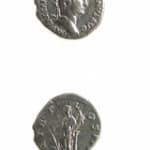Silver Denarius of Emperor Hadrian, 117 CE - 138 CE
Silver
C.5904
Further images
Obverse: IMP CAESAR TRAIAN HADRIANVS AVG; Laureate Bust of the Emperor Facing Righ Reverse: PM TR P COS III; Fortuna Standing to the Left, Leaning on a Column, Holding a...
Obverse: IMP CAESAR TRAIAN HADRIANVS AVG; Laureate Bust of the Emperor Facing Righ
Reverse: PM TR P COS III; Fortuna Standing to the Left, Leaning on a Column, Holding a Rudder and a Cornucopiae
Hadrian spent much of his reign traveling about the Roman Empire and checking into the well - being of the cities, towns, provinces, and ordinary citizens over whom he ruled. He was always interested in civic improvements, and would often have a new bridge, road, aqueduct, or temple built when he thought that the local citizens would benefit by such new construction. The reign of Hadrian at the height of the PAX ROMANA period was a time of great peace and prosperity in the Roman Empire. He continued the public works building projects that his adoptive father Trajan began and strengthened the defenses on the borders of the empire. Because of attacks on Roman citizens living in southern Britain, he built Hadrian's Wall across a narrow part of the island. Hadrian was an educated emperor and a patron of the arts. He spent most of his reign visiting the different provinces of the empire and personally overseeing the improvements and public works carried out under his orders. Like Trajan and Nerva before him, he adopted a grown man in order to make him heir to the throne. When his first adopted son Aelius Caesar died of illness, Hadrian adopted another, Antoninus Pius, who would succeed him when Hadrian died in his bed after a long illness.
How many hands have touched a coin in your pocket or purse? What eras and lands have the coin traversed on its journey into our possession? As we reach into our pockets to pull out some change, we rarely hesitate to think of who might have touched the coin before us, or where the coin will venture to after it leaves our hands. More than money, coins are a symbol of the state that struck them, of a specific time and location, whether contemporary currencies or artifacts of a long forgotten empire. This stunning hand-struck coin reveals an expertise of craftsmanship and intricate sculptural detail that is often lacking in contemporary machine-made currencies. While the legend of Hadrian will live on in the ruins his monumental constructions, perhaps his memory is no better preserved than in coins such as this: intimate memorials passed from the hands of civilization to civilization, from generation to generation that appear as vibrant today as the day they were struck.
Reverse: PM TR P COS III; Fortuna Standing to the Left, Leaning on a Column, Holding a Rudder and a Cornucopiae
Hadrian spent much of his reign traveling about the Roman Empire and checking into the well - being of the cities, towns, provinces, and ordinary citizens over whom he ruled. He was always interested in civic improvements, and would often have a new bridge, road, aqueduct, or temple built when he thought that the local citizens would benefit by such new construction. The reign of Hadrian at the height of the PAX ROMANA period was a time of great peace and prosperity in the Roman Empire. He continued the public works building projects that his adoptive father Trajan began and strengthened the defenses on the borders of the empire. Because of attacks on Roman citizens living in southern Britain, he built Hadrian's Wall across a narrow part of the island. Hadrian was an educated emperor and a patron of the arts. He spent most of his reign visiting the different provinces of the empire and personally overseeing the improvements and public works carried out under his orders. Like Trajan and Nerva before him, he adopted a grown man in order to make him heir to the throne. When his first adopted son Aelius Caesar died of illness, Hadrian adopted another, Antoninus Pius, who would succeed him when Hadrian died in his bed after a long illness.
How many hands have touched a coin in your pocket or purse? What eras and lands have the coin traversed on its journey into our possession? As we reach into our pockets to pull out some change, we rarely hesitate to think of who might have touched the coin before us, or where the coin will venture to after it leaves our hands. More than money, coins are a symbol of the state that struck them, of a specific time and location, whether contemporary currencies or artifacts of a long forgotten empire. This stunning hand-struck coin reveals an expertise of craftsmanship and intricate sculptural detail that is often lacking in contemporary machine-made currencies. While the legend of Hadrian will live on in the ruins his monumental constructions, perhaps his memory is no better preserved than in coins such as this: intimate memorials passed from the hands of civilization to civilization, from generation to generation that appear as vibrant today as the day they were struck.





